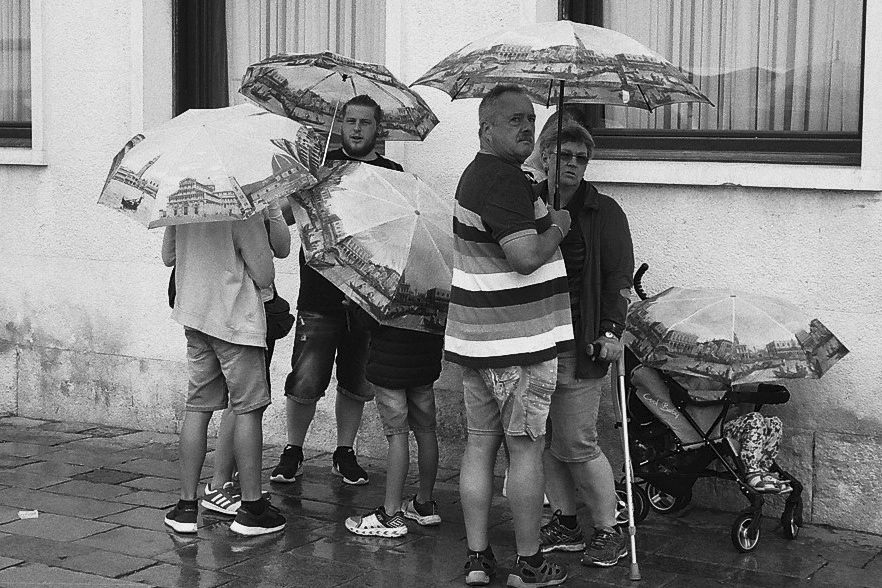I have spent many, many weeks of my life in Venice. I have amassed a great number of images from this incredible city, which I visited for the first time when I was 4. I walked with my grandmother along the canals and went into little cafes. I had my first cup of espresso with 3 sugars. I do not remember, but no doubt I was wired for the next few of hours! But I remember this city as being pure magic from the first time I saw it. All the cool buildings, the canals, the boats, and no cars!
There is a sensation that you get nowhere else, when you enter the city in the lagoon from the only rail and road artery to the mainland. Most pop out of the big, wide and flat modern train station that is one of very few buildings built in the city during the 1930s. Across the canal, past the chaos of vaporettos (water buses), water taxis and flat-bottomed delivery boats, and the odd iconic gondola, there is the first classic church dome. The copper dome of San Simeone Piccolo. This is my first memory of the city. But this blog is not about pretty buildings, canals and bridges, but rather about tourism and what we can do about it.
As tourists, guests and visitors to a city, or country, we have an obligation to participate in the economy in a meaningful way. This means that we stay locally, we eat and drink locally, and contribute to the cultural maintenance of a location by buying museum tickets and perhaps bringing home a trinket, or in the case of Venice, perhaps a great piece of glass. There is the potential for fair trade between tourists and hosts.
In Venice, this has gone completely off the rails. This is in part due to insane cruise ship traffic, which brings visitors to the city in the lagoon, who eat, drink and sleep on their ship and who benefit from volume discounts at museums and galleries and who can be seen walking around in groups with green or red number-stickers on their shirts, or worse with matching hats or jackets. They march like armies of ants through the narrow streets and alleys completely oblivious to everyone around them, listening intensely to a narrative provided by a tour guide, who is rarely local, but has learned the basics from a book, or worse.

Here are the numbers: based on scheduled calls for cruise ships with more than 500 passengers, 1.2 million cruise ship passengers were destined for Venice in 2020, had it not been for Covid19, 56 cruise-lines would have delivered 514 cruise ship arrivals over the year.
Venice is a small city with a shrinking population. The city has a total population of just over 60,000 inhabitants. In 1950, it was 170,000. The number has been falling every year since tourism grew to levels, where it was more profitable to have a shop selling cheap trinkets to tourists than a hardware store. It becomes more and more difficult to live in the city under constant siege from hoards of tourists.

Lots of thinking has been going on during the corona-crisis in the city. What if….. Citizens have enjoyed their own city for the first time in years. People have tried to reimagine what a better managed tourist destination could look like. But I digress. This is a blog about photography, and of course, the city is a wonderful destination for photographers, but also one where the arrival of the cruise ships offer a sad reality that is hard to miss. While I normally do not give cruise ship tourists much time, or film, it is telling that even I, who tries to be timeless in my work, pretending I am local, cannot avoid the disaster that is an overrun city, where more than 1.2 million people come off their cruise ships adding nothing and contributing nothing, but congestion and misery.

I feel strongly that cruise ship traffic to Venice should be banned. The ships are too big, too disruptive, and they damage the seabed and the foundations of the very buildings that tourists come to experience.
Tourist visits should be allowed only, if staying overnight in the city in a hotel. And there should be a minimum-spend per day. I believe countries like Bhutan still enforce a daily minimum spend to help pay for the negative effects of tourism.

There is great beauty in Venice, but it doesn’t work without local people that make it a living, working city. It would be sad, if tourism traffic finally breaks the back of the city and turns it into a Disneyland. I can recommend visiting Las Vegas to see what would happen to Venice, if unscrupulous financial interests are allowed to continue to destroy La Serenissima, the Most Serene Republic.
Sadly, the cruise ship tourists do make for good subjects, but I can certainly live without them.
Harbel

